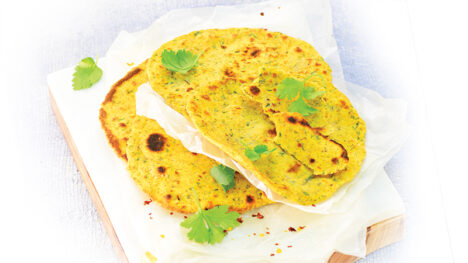Basics of Vegetarianism
March 31, 2013

Thinking of starting on a meat-free diet but not sure how? Kimberley Ellison provides some easy- to-follow steps.
Vegetarianism is a lifestyle choice that is becoming a well-recognised way of eating that’s good for both personal health and for the environment.
What may be surprising is that there are many forms of vegetarianism, ranging from a strict vegan diet, which allows only plant-based foods (no dairy, eggs, animal products or even honey) to the lacto-ovo vegetarian diet, which allows animal products but no animal flesh.
Although it’s never really been mainstream in Western cultures, vegetarianism is not a modern phenomenon. Many cultures throughout history have adopted this approach to food, including the ancient Greeks and Indians.
In India, vegetarianism was closely associated with non-violence, while for the ancient Greeks and Egyptians it was thought to be important for medical purposes and ritual purification
Why Be A Vegetarian?
In contemporary Western culture, people choose to be vegetarian for many different reasons. Here are a few of the most common.
Respect for living creatures
People for the Ethical Treatment of Animals (PETA) state on their website that “farmed animals are every bit as intelligent and capable of feeling pain as the dogs and cats we cherish as our companions. They are inquisitive, interesting individuals who value their lives, solve problems, experience fear and pain, and are capable of using tools.”
Environmental reasons
A 2006 United Nations study concluded that eating meat is “one of the . . . most significant contributors to the most serious environmental problems, at every scale from local to global.” The report concludes that the meat industry “should be a major policy focus when dealing with problems of land degradation, climate change and air pollution, water shortage and water pollution, and loss of biodiversity.”
A healthier choice
One of the most common incentives for being vegetarian is health. The American Dietetic Association, Dietitians of Canada and numerous other dietary organisations, have stated that at all stages of life, a properly planned vegetarian diet is “healthful, nutritionally adequate and provides health benefits in the prevention and treatment of certain diseases.”
Indeed, a variety of large-scale studies in the past few years have confirmed that vegetarians tend to have a lower body mass index, lower cholesterol levels, lower blood pressure and less risk of heart disease, and a lower incidence of hypertension, type 2 diabetes and Alzheimer’s disease. In a 2007 study of 500,000 people, even a relatively low intake of red meat was found to increase a person’s risk of cancer of the oesophagus, colon, rectum, liver and lungs by 20 to 60 per cent. The health benefits seem to go on and on, covering everything from improved mood profiles to longer lives to a reduced risk of animal-to-human disease transmission.
Becoming Vegetarian
However, in spite of all these benefits, many people find it difficult to switch to a vegetarian diet, particularly if they’re accustomed to eating a lot of meat. The following steps can help you to get started.
Take it slowly
Although there’s no problem with quitting meat “cold turkey,” so to speak, the change can be more sustainable if you take it slowly, creating new eating habits as you go.
Try switching incrementally, swapping one meat-based meal for a vegetarian one in your first week or two, increasing that to two a week, then three and so on. This will allow time to learn preparation of new dishes, to use vegetables in new ways and acquire a taste for them. In addition, begin by cutting out red meat from your diet, switching to poultry and fish, with a view to eventually eliminating them completely.
Make friends with fruits, vegetables and meat alternatives
Do some research and find ingredients and dishes that suit your tastes. There are plenty of resources available to help you with this. Check out www.vegweb.com or www.sanitarium.com.au/recipes for some extensive collections of vegetarian recipes. Also, have a look at www.peta.org/vegetarianstarterkit for suggestions on making the switch.
Vegetarian meals can be simple (baked beans and cheese sandwiches) or gourmet (butternut squash and pear ravioli with rosemary sauce). The choice is yours.
Think positive
Becoming a vegetarian doesn’t mean you’re doomed to a life of munching on tasteless leaves. Start with what you do like and you’ll soon find that leaves can be very tasty—and there’s an endless variety of edible options available to you. The key to a healthy diet is to consume a wide variety of foods. So keep an open mind. Experiment with tofu, learn to love lentils and consider upgrading salads from side status to main meal.
Know what to expect
Becoming a vegetarian can mean different things for different people. Some people feel tired at first, but that will pass. Others find that they lose weight or that their skin clears up and they look healthier. There are also some who don’t seem to notice any significant difference in how they look and feel.
What To Watch Out For
Even though a lacto-ovo vegetarian diet can easily provide all the nutrition you need, it can take some time to learn how to get the right balance. Don’t ignore signs that your body isn’t getting what it needs, and be ready to ask an expert for advice. Protein, iron and vitamin B12 are the nutrients most commonly available from meat, so it’s important to know how to get them from a vegetarian diet. And it isn’t all that hard.
Protein
Most vegetarian diets only have a slightly lower level of protein than a meat diet and they can easily meet daily requirements. Eggs and dairy are complete sources of protein, and while a few plant foods (such as soy, chia seed and quinoa) provide all eight essential amino acids, the same coverage is obtained by eating a wide variety of plant foods. One key to obtaining adequate protein is to keep in mind that, while most grains and legumes do not by themselves make up a complete protein, any combination of a grain and a legume usually does.
Iron
Interestingly, vegetarian diets typically contain as much iron as diets where red meat is regularly consumed. The difference is that iron from plants can be more difficult for your body to absorb. Your body relies on other substances you eat to help it absorb iron, of which one of the most effective is vitamin C. Try eating foods rich in iron (such as spinach, black beans, cashews, whole grains and broccoli) in combination with vitamin C-laden foods like citrus, tomatoes and other acid-tasting fruits.
Vitamin B12
Vitamin B12 is essential for a healthy nervous system. Low B12 can be a factor in depression, fatigue and a variety of other health problems. Although your body only needs a tiny amount of B12 to function, it’s impossible to get it from plant foods. Lacto-ovo vegetarians can gain what they need from dairy and eggs, but vegans must rely on fortified foods (some breakfast cereals, for example) or B12 supplements.
Find A Community
Being a vegetarian is much easier when you’re not doing it alone. You might find that when you decide to change your diet, some of your friends or family will take the plunge with you. Joining vegetarian cooking classes is another good way to meet others going through a similar change. Online communities can also provide the support and encouragement you need. Find a couple of informative vegetarian food blogs to follow—try ohmyveggies.com, veggiebelly.com or ohsheglows.com—and join the conversations there.
A Vegetarian’s Shopping List
Here are a few basic items you’ll find indispensable.
- A variety of fresh and frozen fruits and vegetables
- Canned beans (such as kidney beans, black beans, chickpeas)
- Lentils, canned or dried
- Rice
- Pastas
- Canned vegetarian soups (such as tomato, lentil or minestrone)
- Tomato sauce ◗ herbs and spices, fresh or dried
- Whole-grain bread
- Meat alternatives such as tofu and a variety of textured vegetable protein products that are available at many supermarkets
- Milk and cheese (or soy milk and soy cheese if you choose not to eat dairy)
American author and nutritionist, Adelle Davis, once said, “We are indeed much more than what we eat, but what we eat can nevertheless help us to be much more than what we are.” Happy eating!







